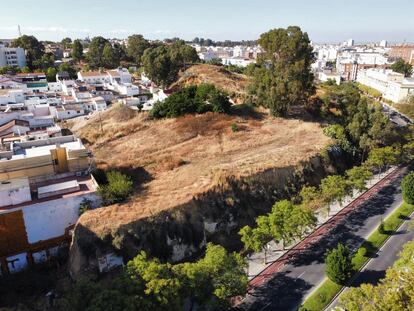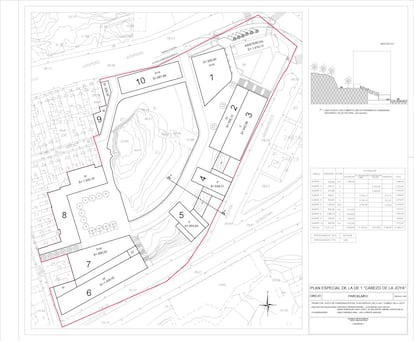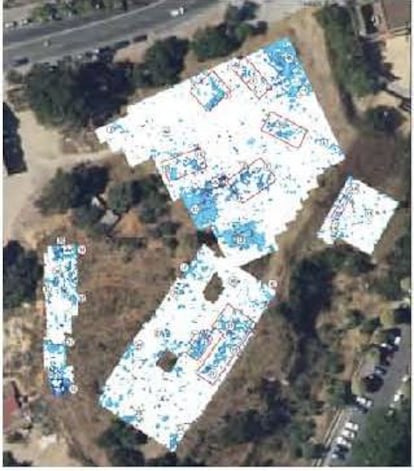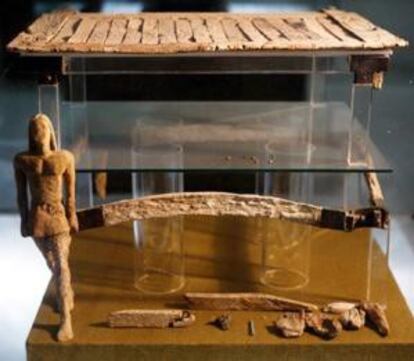Development plans threaten valuable Tartessos necropolis in southern Spain
The city of Huelva is planning to erect 15-story buildings at the base of a hill that has yielded dozens of precious artifacts from an ancient civilization that traded as far as the Middle East


One of the most important Tartessian enclaves in the world was built between the 8th and 6th centuries BC on what is still an undeveloped, elevated piece of land in the center of Huelva, in Spain’s southern region of Andalusia, between the streets of Fray Junípero Serra and San Sebastián. The first excavations were carried out there between the late 1960s and early 1970s, resulting in the discovery of dozens of tombs filled with trousseaus of gold, silver and jewels, an ancient hearse, ceramics and even an Egyptian ivory chest featuring four figurines. The items were of such value that they subsequently went on display in some of the world’s most renowned museums, including New York’s Metropolitan.
The 53-meter-high knoll – known locally as the Cabezo de La Joya – was used by the Tartessians not only as a place to live and bury their dead, but also as a strategic location to control the bay and carry out trade with other parts of the known world. But this rich cultural heritage is about to be cemented over as city authorities in Huelva have chosen the base of the hillock to erect four tower blocks of up to 15 floors each. While the highest part of the knoll will escape being razed by the bulldozers, it will be trapped between the concrete, glass and steel of the new buildings, which will rise five meters above it.
The urban development has triggered protests among scientific and academic communities as well as citizen groups who consider it an attack on Huelva’s heritage. As many as 40 research centers and associations are calling for a halt to the already-approved plan, including the Royal Academy of San Fernando, the Geological Mining Institute of Spain and the Andalusian Ombudsman.

A section of the General Research Plan for the Archaeological Zone of Huelva – signed by the regional department of Culture and Historical Heritage, the University of Huelva, the research group Vrbanitas and the Research Center for Historical, Cultural and Natural Heritage – states that what is now the city center was first established during the first millennium BC, close to a set of hills – or cabezos – by the sea. Over time, the coastline changed and these natural elevations became distanced from the coast, appearing as mounds on an otherwise completely flat terrain. Gradually, they were abandoned as settlements and used instead as fruit orchards and vineyards while the capital crept closer to the sea, devouring the nearby hills as more land was cultivated and later modern buildings constructed.
But long before all this happened, between the end of the second millennium and the beginning of the first millennium BC, the hillocks that made up prehistoric Huelva, namely San Pedro, Cementerio Viejo, Molino de Viento, La Esperanza, Cabezo del Pino, Padre Julián, La Joya, Roma and Mondaca – most of which have now disappeared – provided the communities that occupied them with an excellent place to live and also to bury their dead.
The cabezos were settled by a technologically advanced society, which traded beyond the peninsula, as far as the Middle East. “Its people became familiar with other languages, customs and aesthetics, and had access to fashions and new cultural, technological and religious trends that were implanted in the ancient world,” according to the report.
Aristocratic tombs were found during excavations, with grave goods that are unmatched by those found in other burial grounds from the Orientalizing period of the 7th century BC, which incorporated features from the eastern Mediterranean region. Along with the corpses, there were bronze jars, silver and gold objects, alabaster vases, ivory artifacts and a hearse that would have been pulled by two horses to carry a person of high standing to his grave.
But, now, the General Urban Development Plan of Huelva is about to trample on the past and convert the Cabezo de la Joya into the Execution Unit No. 1, an area of about 26,000 square meters where four towers will stand, despite the fact it has been part of the Huelva Archaeological Zone Declaration since 2001, and is registered in Andalusia’s General Catalog of Historical Heritage within the protected category of Asset of Cultural Interest (BIC in its Spanish acronym).

Jorge Cotallo, president of ArqueoHuelva, a cultural association that does educational work on heritage issues, is outraged. “It is inadmissible,” he says. “The necropolis of La Joya is possibly the most important one in the Orientalizing Tartessian world and, far from protecting and disseminating it, our authorities want to build on top of it!” Meanwhile, the Huelva Te Mira citizens’ association has filed a contentious-administrative appeal against the final approval of the urban plan on the grounds that “it proposes the destruction of much of the hill and the construction of buildings of up to 15 floors.”
In a harsh report issued in September, Andalusian Ombudsman Jesús Maeztu Gregorio de Tejada called for the preservation of all the cabezos, especially La Joya, “which is of international scientific value.” The report said that these knolls “have a natural value in themselves that makes them unique.” It added that the development of La Joya is not considered compatible with the protection of the archaeological zone and is in breach of articles 19, 28.1 and 29.1 of the Law of Historical Heritage of Andalusia.
A spokeswoman for the local government stated that the city council approved the modification of the urban plan last November and all that remains to be drafted are projects focusing on where the roads will be laid and the buildings located. The plan was approved with votes from the Socialist Party (PSOE); there were abstentions from the Popular (PP), the far-right Vox and the center-right Ciudadanos (Citizens), while the local parties Mesa de la Ría and Adelante Huelva cast negative votes.

Thanks to the first excavations, dozens of Tartessian tombs have been documented. In tomb number 17, said to be the richest and most unique trousseau of all those in the necropolis, a disassembled chariot that would have been pulled by two horses was unearthed. The experts’ report reads as follows: “It has been understood as a two-wheeled chariot, due to the presence of two hubcaps with feline heads.” Among its elements were the reinforcements of the central rudder, a silver mould, the lining of the end of the spear, a quiver-box for arrows, rein buckles, reinforcements decorated with rosettes, two horse bits and bronze fastening rods.
An ivory chest was found in another of the tombs with silver hinges, pins and bronze corner pieces that join an armature featuring four Egyptian-style figurines made from ivory.

In 1999, an emergency dig was carried out due to the need to build a health center at the base of the hill during which more tombs and a ceramic trousseau were found. However, the neglect to which the area has been subjected has meant regular looting has taken place, particularly when official excavations have made the booty more accessible.
The experts who carried out the archaeological diagnosis for the General Research Plan of the Archaeological Zone of Huelva point out that the local government claims there are no archaeological remains in the lower part of the hill, which, besides being inaccurate, is an assumption made before the archaeological diagnosis report could be delivered.

Historians say that the Odiel River could be clearly observed from the top of the hill, the same spot where the archaeological site known as the Huelva Estuary Deposit was located in 1923, which turned up bronze swords and other metallic objects that were sacred offerings to the waters. Nor should it be forgotten, add these experts, that the island of Saltés is also visible from this spot. Saltés was a source of sacred votive offerings, according to the experts, making it a place of special relevance that would have been considered sacred in itself. The proposal is that the area be completely free of urban development and become an area for the interpretation of heritage.
“But city officials are not interested,” insists Cotallo. “Instead of preserving and adding value to a unique Tartessian site, they prefer to put up four apartment blocks that will destroy it and cover it. The systematic destruction of Huelva’s heritage is unrelenting. Is nobody going to do anything about it?”
English version by Heather Galloway.
Tu suscripción se está usando en otro dispositivo
¿Quieres añadir otro usuario a tu suscripción?
Si continúas leyendo en este dispositivo, no se podrá leer en el otro.
FlechaTu suscripción se está usando en otro dispositivo y solo puedes acceder a EL PAÍS desde un dispositivo a la vez.
Si quieres compartir tu cuenta, cambia tu suscripción a la modalidad Premium, así podrás añadir otro usuario. Cada uno accederá con su propia cuenta de email, lo que os permitirá personalizar vuestra experiencia en EL PAÍS.
¿Tienes una suscripción de empresa? Accede aquí para contratar más cuentas.
En el caso de no saber quién está usando tu cuenta, te recomendamos cambiar tu contraseña aquí.
Si decides continuar compartiendo tu cuenta, este mensaje se mostrará en tu dispositivo y en el de la otra persona que está usando tu cuenta de forma indefinida, afectando a tu experiencia de lectura. Puedes consultar aquí los términos y condiciones de la suscripción digital.
More information
Últimas noticias
There is as much life left to discover on planet Earth as that which is already known
Dozens presumed dead, around 100 injured in fire at Swiss Alps bar during New Year’s celebration
Is porn for women different from conventional porn? We spoke to those who make it
Cartagena de Indias is sinking: What can the city do to mitigate it?
Most viewed
- Reinhard Genzel, Nobel laureate in physics: ‘One-minute videos will never give you the truth’
- David King, chemist: ‘There are scientists studying how to cool the planet; nobody should stop these experiments from happening’
- Sinaloa Cartel war is taking its toll on Los Chapitos
- Oona Chaplin: ‘I told James Cameron that I was living in a treehouse and starting a permaculture project with a friend’
- The Interoceanic Train, the Mexican alternative to the Panama Canal








































